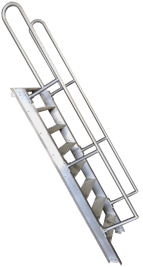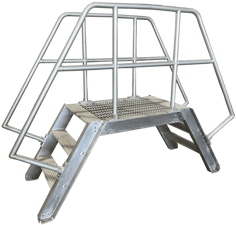 Part stair and part ladder, ships ladders, sometimes called ships stairs, crossover ladders, or crossover stairs are essential to the efficiency and comfort of vertical circulation in mechanical spaces and service areas. The term ships ladder dates back more than a century because “back in the day,” tight spaces on cargo ships required the use of non-graduated, relatively steep stairs that gave these ladders their name.
Part stair and part ladder, ships ladders, sometimes called ships stairs, crossover ladders, or crossover stairs are essential to the efficiency and comfort of vertical circulation in mechanical spaces and service areas. The term ships ladder dates back more than a century because “back in the day,” tight spaces on cargo ships required the use of non-graduated, relatively steep stairs that gave these ladders their name.
On a related note, the term crossover ladder refers to a feature of ships ladders that allows them to “cross over” mechanical equipment, pipes, and other objects that would be difficult or impossible to walk on, around, or through.
 Some ships ladders are made of steel, but most, including ours, are made of aluminum. By using a non-ferrous metal to manufacture ships ladders, these climbing structures are ideally suited for use in water treatment plants, food and beverage processing facilities, laboratories, and other environments that require frequent washing or are exposed to the elements.
Some ships ladders are made of steel, but most, including ours, are made of aluminum. By using a non-ferrous metal to manufacture ships ladders, these climbing structures are ideally suited for use in water treatment plants, food and beverage processing facilities, laboratories, and other environments that require frequent washing or are exposed to the elements.
Although ships ladders’ dimensions vary based on application, the ladder angle is usually 60°-70° which is steeper than the typical 45° angle of standard ladders. A typical ships ladder width is 24” and has a tread depth of 6”.

What the Regulations Say
To help optimize workplace safety, the U.S. Occupational Safety and Health Administration (OSHA) provides clear guidance for the use of ships ladders. In 29 CFR Section 1910.25, the regulations clearly state that ships stairs should be used only in locations where it is not possible to use standard stairs. The details are spelled out here.
OSHA requirements include the need for guardrails, handrails, a vertical clearance of 6’8”, and uniform treads or risers. Additionally, a ships ladder must be able to handle live loads of at least 5X the anticipated loads but not less than 1,000 pounds per point load, a load applied to a specific concentrated point. You may refer to it as equivalent concentrated load (ECL). In contrast, a uniformly distributed load (UDL) is distributed across an entire object such as a beam or slab.
What’s more, the slope must be “50° to 70° from horizontal” (i.e., the ground) and open risers – the vertical space between one step and another -- must be 6.5” to 12”.
On a related note, the International Building Code (IBC), a set of standards developed by the International Code Council, calls for a maximum riser height of 9.5". Likewise, the OSHA regulations stipulate a minimum tread depth (stair height) of 4” while the IBC calls for a 5” minimum depth.
OSHA regulations also call for the width to be at least 18”, a requirement that in our experience 99.9% of ships ladders meet.
 Ours vs. Theirs
Ours vs. Theirs
When determining the best ships ladder or crossover ladder for a specific application, there are numerous factors to consider. While most ladders are made of light gauge bent plate stringers (the side supports that hold a ladder’s stairs or rungs in place), ours feature structural aluminum channel stringers that are sturdier and longer lasting.
Likewise, while other manufacturers use light gauge materials to manufacture extruded treads that help users steady themselves, our ladders use heavy duty aluminum extruded treads that give users firmer footing on every step.
In addition, other manufacturers attach their treads to steps by using sheet metal screws that can easily become loose through normal wear, compromising worker safety. In contrast, we attach our treads with 5/16” machine bolts which allow the tread to remain in place throughout the working life of the ships stairs or crossover ladder.
Regarding handrail material, most manufacturers use light gauge tube. Instead, we use Schedule 40 pipe, a 6105-T5 aluminum pipe, allowing users to get a firmer grip when climbing both up and down, decreasing the probability of injury and lost time. What’s more, the typical handrail is made of welded components with connections that can deteriorate over time. To prevent those occurrences, our handrails feature engineered components that fit together perfectly like pieces of a puzzle.
To make sure you’re getting the safest ships stairs, crossover ladders or crossover stairs…